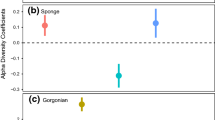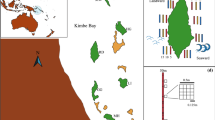Abstract
Previous work on tropical sponge assemblages has provided strong evidence that sponges coexist on coral reefs through a diversity of positive and negative associations; however, the majority of this work has focused on Caribbean coral reefs. Here, we investigate the intra-phyletic spatial associations between the 20 most abundant sponge species at two sites experiencing different environmental regimes in the Wakatobi National Marine Park, Indonesia. We used a Monte Carlo simulation approach to compare the number of spatial associations between each species pair to that expected if species distribution patterns were non-associative (i.e. random). We found that sponges were predominately randomly distributed at the high coral cover site, whereas most sponges were negatively associated with other sponges at the sedimented, low coral cover site. We also found differences between distribution patterns for specific species at the two sites; a number of species that showed a random distribution pattern at the high coral cover site had negative association patterns at the low coral cover site. Our research supports recent ecological studies suggesting that interactions between species are unlikely to be homogenously distributed, as we found that some sponge species interactions differed depending on the environmental regimes in which they were found; this suggests that species interactions may be spatially variable. Finally, our results contrast with studies from elsewhere, as the sponge assemblages at these two sites in the Wakatobi appear to be dominated by negative associations and random distribution patterns rather than widespread competition.

Similar content being viewed by others
References
Aerts LAM (1998) Sponge-coral interactions in Caribbean reefs: analysis of overgrowth patterns in relation to species identity and cover. Mar Ecol Prog Ser 175:241–249
Aerts LAM (2000) Dynamics behind standoff interactions in three reef sponge species and the coral Montastrea cavernosa. Mar Ecol 21:191–204
Aerts LAM, van Soest RWM (1997) Quantification of sponge/coral interactions in a physically stressed reef community, NE Colombia. Mar Ecol Prog Ser 148:125–134
Ávila E, Carballo JL (2009) A preliminary assessment of the invasiveness of the Indo-Pacific sponge Chalinula nematifera on coral communities from the tropical Eastern Pacific. Biol Inv 11:257–264
Bascompte J (2009) Disentangling the web of life. Science 325:416–419
Bascompte J, Jordano P (2007) Plant–animal mutualistic networks: the architecture of biodiversity. Ann Rev Ecol Evol Sys 38:567–593
Becking LE, Cleary DFR, de Voogd NJ, Renema W, de Beer M, van Soest RWM, Hoeksema BW (2006) Beta diversity of tropical marine assemblages in the Spermonde Archipelago, Indonesia. Mar Ecol 27:76–88
Bell JJ (2007a) Contrasting patterns of species and functional composition for coral reef sponge assemblages. Mar Ecol Prog Ser 339:73–81
Bell JJ (2007b) The use of volunteers for conducting sponge biodiversity assessments and monitoring using a morphological approach on Indo-Pacific coral reefs. Aquat Conserv Mar Fresh Ecosyst 17:133–145
Bell JJ (2008) The ecological roles of marine sponges. Est Coast Shelf Sci 79:341–353
Bell JJ, Barnes DKA (2003) The importance of competitor identity, morphology and ranking methodology to outcomes in interference competition: an example of sponges. Mar Biol 143:415–426
Bell JJ, Smith DJ (2004) Ecology of sponges in the Wakatobi region, south-eastern Sulawesi, Indonesia: richness and abundance. J Mar Biol Assoc UK 84:581–591
Briggs JC (1987) Biogeography and plate techtonics. Developments in palaeontology and stratigraphy. Elsevier, Amsterdam
Cleary DFR, Becking LE, de Voogd NJ, Renema W, de Beer M, van Soest RWM, Hoeksema BW (2005) Cross-shelf diversity of sea urchins, sponges, mushroom corals and foraminifera in the Spermonde Archipelago, Indonesia. Est Coast Shelf Sci 65:557–570
Crabbe J, Smith DJ (2002) Real-time monitoring of reef health and coral recruitment using digital videophotography and computer image analysis and modelling in the Wakatobi Marine National Park, S.E. Sulawesi, Indonesia. Coral Reefs 21:242–244
de Voogd NJ (2007) The mariculture potential of the Indonesian reef-dwelling sponge Callyspongia (Euplacella) biru: growth, survival and bioactive compounds. Aquaculture 262:54–64
de Voogd NJ, Cleary DFR (2007) Relating species traits to environmental variables in Indonesian coral reef assemblages. Mar Fresh Res 58:240–249
de Voogd NJ, Becking LE, Noor A, Hoeksema BW, van Soest RWM (2004) Sponge interactions with spatial competitors in SW Sulawesi. Boll Mus Ist Biol Univ Genova 68:253–261
de Voogd NJ, Haftka JJH, Hoeksema BW (2005) Evaluation of the ecological function of amphitoxin in the reef-dwelling sponge Callyspongia (Euplacella) biru (Haplosclerida: Callyspongiidae) at southwest Sulawesi, Indonesia. Contrib Zool 74:51–60
de Voogd NJ, Cleary DFR, Hoeksema BW, Noor A, van Soest RWM (2006) Sponge beta diversity in the Spermonde Archipelago, Indonesia. Mar Ecol Prog Ser 309:131–142
Diaz MC, Rützler K (2001) Sponges: an essential component of Caribbean coral reefs. Bull Mar Sci 69:535–546
Diaz MC, Alvarez B, Laughlin RA (1990) The sponge fauna on a fringing coral reef in Venezuela, II: community structure. In: Rützler K (ed) New perspectives in sponge biology. Smithsonian Institute Press, Washington, pp 367–375
Hooper JN, Lévi C (1994) Biogeography of Indo-west Pacific sponges: Microionidae, Raspialiidae, Axinellidae. In: van Soest RWM, van Kempen TMG, Braekman JC (eds) Sponges in time and space. Balkema, Rotterdam, pp 191–212
Rützler K (1970) Spatial competition among Porifera: solution by epizoism. Oecologia 5:85–95
Rützler K (2004) Sponges on coral reefs: a community shaped by competitive cooperation. Boll Mus Ist Biol Univ Genova 68:85–148
Sarà M (1970) Competition and cooperation in sponge populations. Sym Zool Soc Lond 25:273–284
Schmahl GP (1990) Community structure and ecology of sponges associated with four southern Florida coral reefs. In: Rützler K (ed) New perspectives in sponge biology. Smithsonian Institute Press, Washington DC, pp 376–383
Turon X, Becerro MA, Uriz MJ, Llopis J (1996) Small-scale association measures in epibenthic communities as a clue for allelochemical interactions. Oecologia 108:351–360
Van Soest RMW (1994) Demosponge distribution patterns. In: van Soest RWM, van Kempen TMG, Braekman JC (eds) Sponges in time and space. Balkema, Rotterdam, pp 213–223
Wulff JL (1997) Mutualisms among species of coral reef sponges. Ecology 78:146–159
Wulff JL (2001) Assessing and monitoring coral reef sponges: why and how? Bull Mar Sci 69:831–846
Wulff JL (2005) Trade-offs in resistance to competitors and predators, and their effects on the diversity of tropical marine sponges. J Appl Ecol 74:313–321
Wulff JL (2006) Ecological interactions of marine sponges. Canadian J Zool 84:146–166
Wulff JL (2007) Collaboration among sponge species increases sponge diversity and abundance in a seagrass meadow. Mar Ecol 29:193–204
Wulff JL (2008) Life-history differences among coral reef sponges promote mutualism or exploitation of mutualism by influencing partner fidelity feedback. Am Nat 171:596–609
Acknowledgments
We are indebted to the staff of the Hoga Island research station, whose help has been invaluable in allowing us to conduct research in Indonesia. Dr. Bell would also like to express his gratitude to Operation Wallacea for financial and logistic support for his research since 2003, which has allowed access to research facilities in the WNMP. Finally, Dr. Bell is grateful to the PADI Foundation for providing financial assistance for this specific project.
Author information
Authors and Affiliations
Corresponding author
Additional information
Communicated by F. Bulleri.
Rights and permissions
About this article
Cite this article
Bell, J.J., Berman, J., Jones, T. et al. Variability in the spatial association patterns of sponge assemblages in response to environmental heterogeneity. Mar Biol 157, 2503–2509 (2010). https://doi.org/10.1007/s00227-010-1514-5
Received:
Accepted:
Published:
Issue Date:
DOI: https://doi.org/10.1007/s00227-010-1514-5




